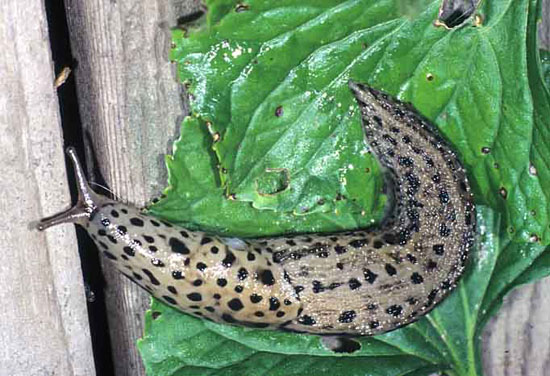Issue 10, June 29, 2015
Slugs
Slugs are shell-less snails that feed on dead organic matter in moist environments. They are soft-bodied with two pairs of tentacles. The upper, longer pair are optic tentacles with eyes on the tips. There is also a shorter pair near the ground that are sensory tentacles for feeling and smelling. Near the front of the body on the right side is a hole or slit called a pneumostome, which is the opening that leads to the slug's single lung. The largest structure is the foot, which runs the length of the slug. The underside of the foot is called the sole.
The gray garden slug is very common and about one inch long. Although called gray, they come in white, yellow, lavender, purple, or blackish with brown specks and mottled areas. A less common species in Illinois is the spotted garden slug, which can be seven inches long but is more commonly three to five inches in length. Although small individuals tend to be dark gray to black, large ones are yellow to brown with black mottling and three rows of black spots running down the posterior half of the body.

Spotted garden slug.
High moisture levels allow slugs to leave turf and mulched areas to climb on lawn furniture and up the sides of houses, particularly at night and on damp mornings. They leave slime trails wherever they go that glisten like silver ribbons in the morning sunlight. Slugs eat holes in the leaves of thin-leaved, shade-loving plants such as hosta, violets, and impatiens.
Slugs are most effectively controlled by reducing the amount of moisture or dead organic matter. They can be controlled with slug baits containing iron phosphate (Sluggo, Escar-Go) or metaldehyde (Deadline). Iron phosphide baits are generally the best option as other slug baits are poisonous to dogs, cats, and other mammals. Copper strips that extend an inch or more below and above the soil line will keep out slugs. The copper apparently generates an electrical charge that is large enough to deter slugs.
Most other slug remedies are not reliably effective. The mucus that slugs produce allows them to cross a razor-blade edge without harm, making the use of sharp gravel, broken glass, and cinders of dubious value. Beer in shallow dishes is effective sometimes, although my experience is that this method allows the harvest of slugs but doesn't actually control them. Diatomaceous earth is not very effective in the damp environment that slugs inhabit. Salt, lime, and other chemicals may disrupt the soil's fertility until nothing will grow, which defeats the purpose. Because slugs and snails are mollusks (very distantly related to insects and other arthropods), insecticides are not effective. (Phil Nixon)